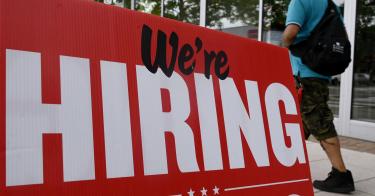There’s not much good to say about the U.S. economy today, with out-of-control inflation eroding household incomes and Americans bracing for a recession after gross domestic output shrunk in the first half of 2022.
But the labor market is the wildcard.
There are nearly two job openings for every unemployed worker, and half of businesses have job openings they’re unable to fill. Since the start of the pandemic, the working-age population (16+ years) has increased by 4.4 million, yet there are 576,000 fewer people employed today.
If the employment-to-population ratio were the same today as it was in February 2020, more than 3 million additional people would have jobs. With that many more people producing goods and services, would it be enough to turn negative GDP growth positive? The relationship between employment and economic output suggests yes.
>>> Why Biden’s Student Loan “Forgiveness” Will Make Inflation, Labor Shortage Worse
A popular rule-of-thumb called Okun’s law (named after economist Arthur Okun) says that each one-percentage-point decrease in the unemployment rate corresponds to a roughly two-percentage-point increase in the growth rate of real GDP.
Right now, unemployment is low, and GDP growth is negative. Those two don’t usually go hand in hand, but we’re in unusual times where demand for goods and services is high, but there aren’t enough workers to meet those demands. That suggests that the disappearance of more than 3 million active workers has contributed to the decline in GDP in the first half of 2022 and their re-entry into employment might have prevented that decline.
Suppose all those “missing” workers had never left the labor force but were classified as unemployed. (The official unemployment designation is based on whether a jobless person is looking for work, but the fact remains that they are not contributing to output.) The unemployment rate would have been about 1.9 percentage points higher in the first half of this year. But if those workers found employment among the 11.4 million job openings that existed in the first half of 2022, the unemployment rate would have subsequently declined by about 1.9 percentage points.
That increase in employment (or decrease in the potential unemployment rate) would have meant more output, which gets to the crux of Okun’s law relating economic output to the difference between people being productively employed or unproductively unemployed.
Applying a 2-to-1 ratio between output and unemployment, the productive employment of 3.2 million missing workers might have shifted the pace of GDP growth from -1.6% to 2.4% in the first quarter and from -0.9% to 2.9% in the second quarter.
That seems like a big jump, but the recovery from COVID-19 was supposed to be strong and longer-lasting. In January 2021, Moody’s estimated that GDP growth would be 8% in 2021 and 4% in 2022. Instead, it was 5.7% in 2021 and negative so far in 2022.
And it’s not for a lack of demand. Canceled flights, delayed deliveries, unopened community pools, over-crowded emergency rooms, missing bus drivers and teachers, reduced public safety, shortages of goods and services, rising prices, and all the extra human resources needed to find and retrain new workers (instead of directly producing goods and services) demonstrate how missing workers have meant less output.
Could a reversal of the decline in work spare the U.S. a recession?
Theoretically, yes. But it’s not possible for millions of people to immediately jump back into the workforce and into productive jobs. A gradual reentry could absolutely minimize economic decline, but the necessary ingredients for a strong workforce have drastically deteriorated.
>>> An Unprecedented Labor Shortage
For starters, welfare-without-work benefits and school lockdowns were a major setback for young peoples’ work and income prospects. Individuals between the ages of 20 and 24 have experienced larger employment declines than any other age group besides those 65 and older. And at the same time, their college enrollment plummeted over 9%.
Policymakers could help increase employment among young workers by expanding alternative education options—including reviving Industry Recognized Apprenticeship Programs—and by making welfare work-oriented.
And to help increase employment among older workers, policymakers should protect flexible, independent work opportunities that allow people to be their own bosses. They also should eliminate Social Security’s retirement earnings test, which discourages older Americans from working.
Current policies to spend more, tax more, regulate more, and produce less will only make labor shortages and inflation worse. But it’s not too late for policymakers to minimize the severity of the current economic downturn by removing government-imposed barriers to work and by getting the federal government’s fiscal house in order.
This piece originally appeared in The Sacramento Bee




